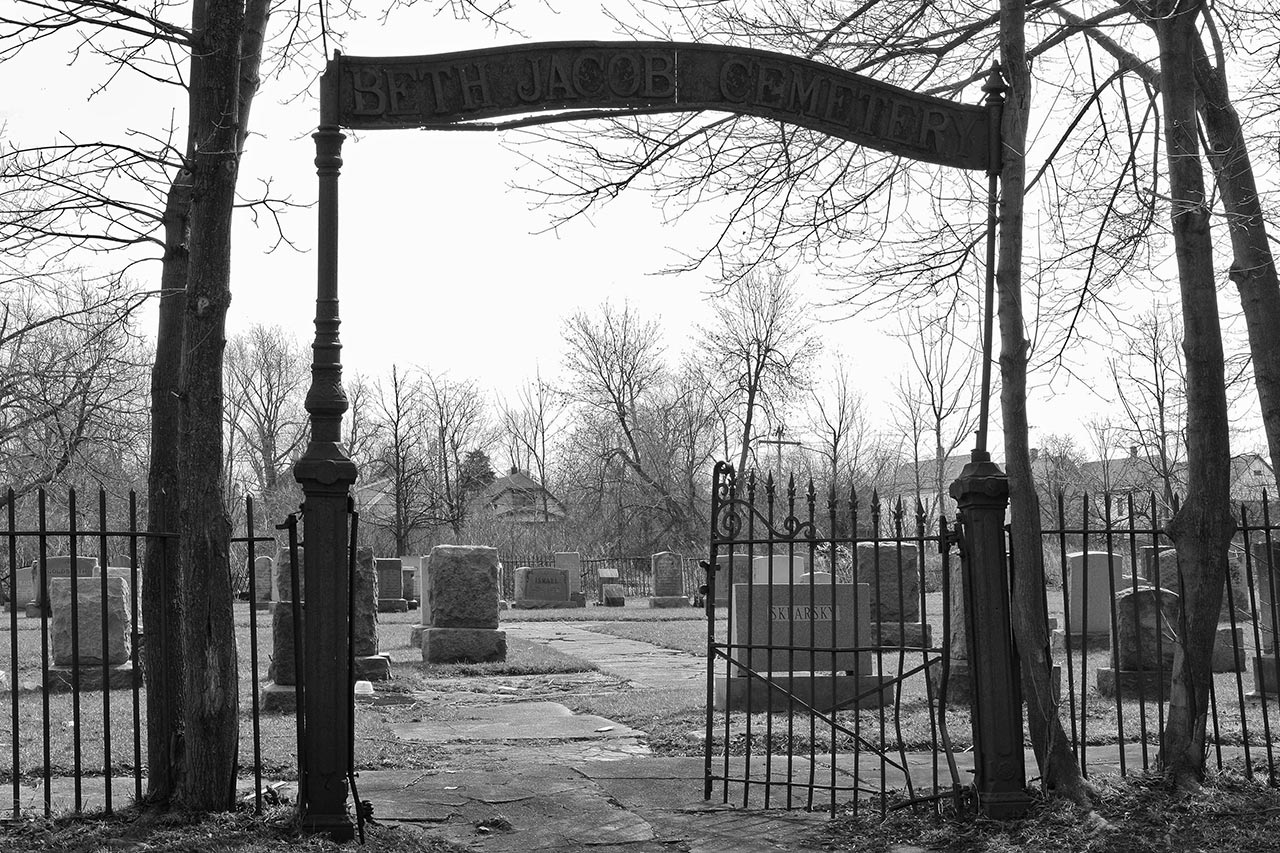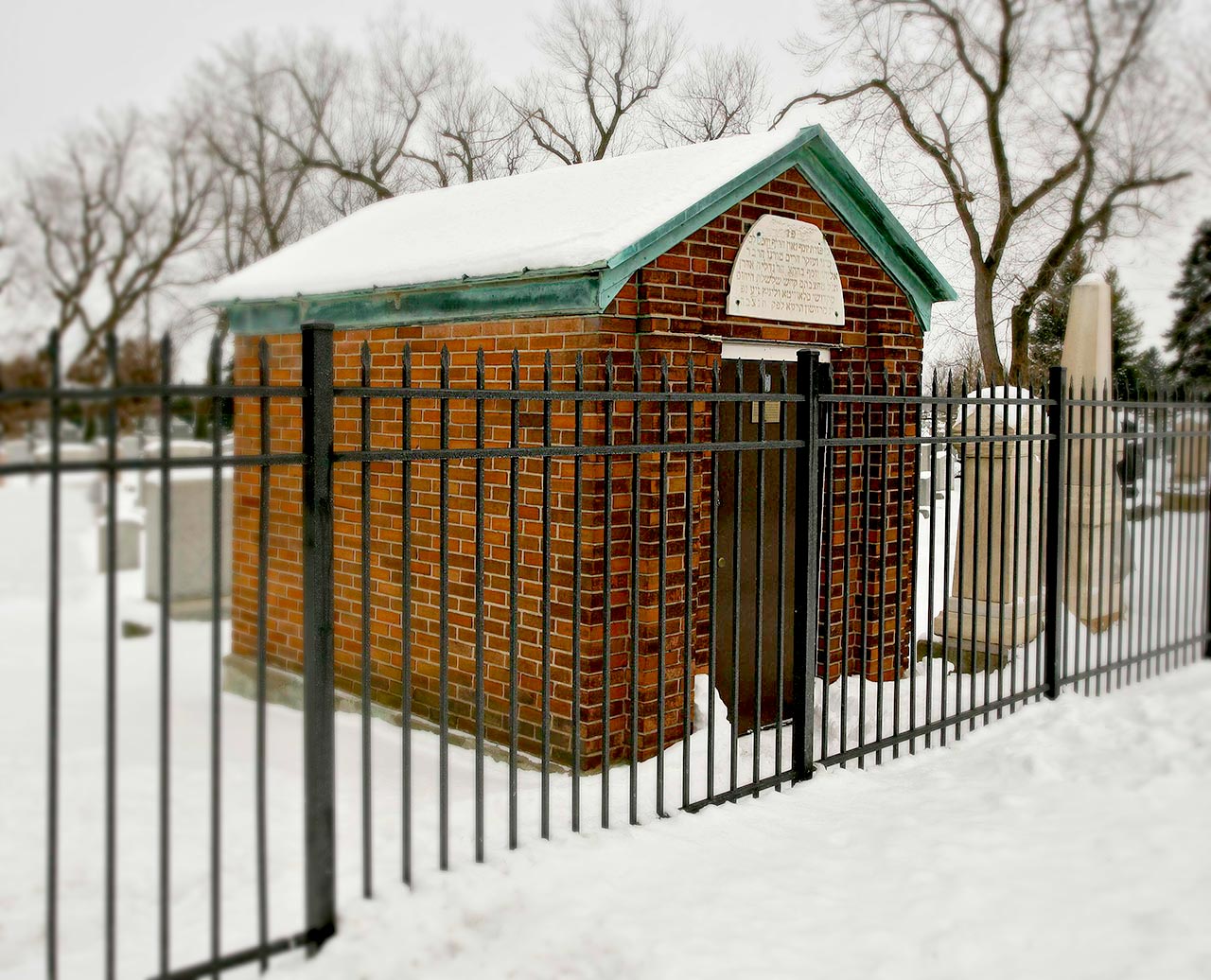Organizations / Cemeteries
Establishing a cemetery is often the first communal act of a new Jewish community, synagogue or fraternal organization enabling Jews to be buried in keeping with Jewish traditions.
Overview
Cemeteries have many names in the Jewish tradition, and each emphasizes a particular link to the living. A basic Hebrew term for a cemetery or graveyard is beit kevarot (Hebrew: Beit=house, kevarot=graves) from the biblical passage, “graveyard of my ancestors” in Nehemiah 2:3. An alternative term, beit avot (Hebrew: Beit=house, avot=fathers or ancestors) stresses the links between generations. A third term is, “house of the living” (in our memory) beit chayim (Hebrew: Beit=house, chayim=living). Another term with biblical links is beit olam (Hebrew: Beit=house, Olam=eternity), from the passage that references “eternal abode” in Ecclesiastes, 12:5. The Aramaic term for house of eternity or eternal abode is similar to the Hebrew and used by some, beit olmin (Beit=house, Olmin=eternity). A third biblical passage – Job 30:23 – references the “the house assigned for all the living,” rendered in Hebrew as Beit moed le-chol chai (Hebrew: Beit=house, moed=meeting, le-chol=for all, chai=living). None of the names refer to burial or death, rather they preserve a physical record of a loved one with a living relative who maintains their departed one’s memory.
Jews are generally buried in Jewish cemeteries, however separate sections within military or non-sectarian cemeteries are alternatives that have occurred as part of historical and current practice. Although it is common for a Christian graveyard to be on land attached to, or next to, a church, most of the Jewish cemeteries in Greater Buffalo, as in other Jewish communities, are far away from their associated synagogues because of the rules around Kohanim coming into contact with the dead. The Talmudic tractate Bava Batra 25a rules that a cemetery must be located at a minimum distance of approximately 75 feet from the city (Talmudic tract: Bava Batra 25a). Historically, however, there are deviations from this rule, most notably in Prague, and other historical Jewish ghettos. In these cases, high walls were erected around the cemetery to provide a barrier for Kohanim to pass around.
Grave design
Grave design is also prescribed by specific guidelines. Each deceased individual is buried in a single grave, and the distance between the graves should be six spans (or tefah, a unit equal to about four- and-a-half feet) according to the mandate: “The dead should not be buried one alongside the other unless a partition separated them.” (Shlomo Ganzfried, Kitzur Shulchan Aruch, Jerusalem: Ortot Haim, 1989). Sometimes a separate structure is used for burial, and is known as an “ohel” [Hebrew: Tent], but these are usually reserved for a revered rabbi. Buffalo is home to the ohel of Rabbi Eliyahu Yosef Rabinowitz, Linzer Rebbe from Buffalo.
Gravestones or monuments often have six elements. The first line, or the top section includes a carved decoration or iconography. The second line is optional, and is an introductory line (Beloved Mother, Wife). The third line indicates the person’s name in Hebrew and English. The fourth line includes the persons date of death by both Hebrew and secular calendars. The fifth line indicates the age of deceased, and the sixth line includes an epitaph, ranging from traditional abbreviation to extensive verse.
Two common tombstone inscriptions or abbreviations often appear on tombstones. The first includes two Hebrew letters, as an acronym for “Here is buried” Poh Nikbar, with the Hebrew letter pey for the word “poh” (meaning “here”), and nun for “nikbar” (meaning “buried”). Another Hebrew letter acronym תנצב”ה derives from I Samuel 25:29, transliterated as, “t’hay nafsho/ah tzrurah b’tzror hachaim,” and translated as “May his/her soul be bound up in the bond of life.”
Gravestones often include a Hebrew dating system. A luach converter (Hebrew: Calendar) is a handy tool for converting the Hebrew date to the Gregorian date. Dates, days and months are assigned Hebrew letters and can be explored here.
Reading Names on a grave stone
Even if you don’t read a lot of Hebrew, you can learn to recognize popular names with a guide. Common men’s first names in Hebrew include those with biblical links such as Abraham, Isaac, Jacob, Simcha and Tuviah. Common men’s first names in Yiddish include Leib, Wolf, Mendel, Hirsch, Meyer and Heschel. Common women’s first names in Hebrew with biblical links include Eve (Chaya), Sarah, Rachel, Rebecca, Esther, and Hannah. Common women’s first names in Yiddish include Bluma, Fruma, Yetta, Golda, Etta and Shayna. A helpful reference listing of common men’s and women’s names appears in Joshua L. Segal, A Field Guide to Visiting a Jewish Cemetery, Jewish Cemetery Publishing, Bennington: NH, 2005, p. 82-86.
Some gravestone include transliteration issues that make translating from the Hebrew to English more difficult, as practices vary from person to person and place to place! A wide variety of spellings for first names, nicknames and family names exists, and even place names, if included. For example, variant names for Hannah include Chana, Hana, Hanna, Chanah, Anna, Ann, Chani, Channa, and Henna. Variant names for a family surname like Schwartz includes Schvartz, Shwartz, Schwacz, Swartz and more.
Iconography
The iconography included on a gravestone generally falls into one or more of four main categories: Symbols of nature (animals, plants and trees), symbols of gender (woman) or roles and professions (rabbi, Levite, Cohen), symbols of piety and symbols of Judaism. If a grave stone includes two hands with outspread fingers, this indicates that the deceased is a Cohen or descendant of Kohanim, a priestly caste. Similarly, a Levi, also a priestly caste, is usually represented with a jug, pitcher or bowl. Other roles, such as a scholar are indicated by books. Women’s graves often include candles or candlesticks. A crown can signify a revered rabbi. A shofar (ram’s horn) indicates that the deceased was a blower of the shofar, or was a religious functionary. A broken branch generally indicates that the individual died at a young age. A charity [tzedakah] box often indicates generosity and piousness. More general symbols include the Magen David (Star of David) or a menorah. Some Jewish tombstones also include occupational and other symbols such a bookbinder, fraternal organizations or military service.
Cemeteries
Beth Jacob Cemetery
Cemeteries / Beth Jacob CemeteryCemetery Map
Forest Lawn Cemetery
Cemeteries / Forest Lawn CemeteryForest Lawn Cemetery Map
Elmlawn Memorial Park
Cemeteries / Elmlawn Memorial ParkJewish Cemetery Sections within Elmlawn Memorial Park
Pine Ridge Cemeteries
Cemeteries / Pine Ridge CemeteriesJewish Cemetery Sections within Pine Ridge
White Chapel Memorial Park
Cemeteries / White Chapel Memorial ParkJewish Cemetery Sections within White Chapel Memorial Park
Reference Guides
- Beider, Alexander, A Dictionary of Jewish Surnames from the Russian Empire (Bergenfield NJ, 2008 [2nd ed.]).
- Beider, Alexander, A Dictionary of Ashkenazic Given Names New Jersey, 2001
- Blatt, Warren, “Given Names”, in Sallyann Amdur Sack, Gary Mokotoff (eds.) Avotaynu Guide to Jewish Genealogy, (Bergenfield, NJ, 2004), pp.35-42
- Friedman, Chaim, “Rabbinical Research”, in Sallyann Amdur Sack, Gary Mokotoff (eds.) Avotaynu Guide to Jewish Genealogy, (Bergenfield, NJ, 2004), pp.77-89
- Krajewska, Monika. A Tribe of Stones: Jewish Cemeteries in Poland. (Warsaw, 1993)
- Kugelmass, Jack and Jonathan Boyarin, From a Ruined Garden, Second Expanded Edition: The Memorial Books of Polish Jewry, Indiana-Holocaust Museum Reprint, 1998.
- Kurzweil, Arthur. From Generation to Generation: How to Trace Your Jewish Genealogy and Personal History. New York: Schocken Books, 2nd ed. 2011
- Kurzweil, Arthur. “Genealogy as a Spiritual Pilgrimage.” In Avotaynu Guide to Jewish Genealogy. Eds. Sallyann Amdur Sack and Gary Mokotoff. Bergenfield, NJ: Avotaynu, 2004.
- Malka, Jeffrey S. Sephardic Genealogy: Discovering Your Sephardic Ancestors and Their World, Avotaynu. Updated edition, 2009.
- Menachemson, Nolan, Practical Guide to Jewish Cemeteries (Bergenfield NJ, 2007)
- Mokotoff, Gary. “Proposal for a Jewish Soundex Code.” Avotaynu 1, no. 1 (January 1985): 5-7.
- Mokotoff, Gary, “A Proposed Standard for Names, Dates and Places in a Genealogical Database” in AVOTAYNU, xxiv, 3 (Fall 2008), pp. 3-6.
- Rottenberg, Dan. Finding Our Fathers: A Guidebook to Jewish Genealogy. New York: Random House, 1977.
- Rottenberg, Dan. “Tracing Jewish Ancestors: A Pioneer Looks Back.” Avotaynu 5, no. 3 (Fall 1989):3-6.
- Sack, Sallyann Amdur and Gary Mokotoff (eds.) Avotaynu Guide to Jewish Genealogy, (Bergenfield, NJ, 2004
- Sack, Sallyann Amdur, “Family Names”, in Sallyann Amdur Sack, Gary Mokotoff (eds.) Avotaynu Guide to Jewish Genealogy, (Bergenfield, NJ, 2004), pp.30-34
- Sachs, Arlene and Blatt, Warren, “Cemetery Research”, in Sallyann Amdur Sack, Gary Mokotoff (eds.) Avotaynu Guide to Jewish Genealogy, (Bergenfield, NJ, 2004), pp. 90-93.
- Schafer, Louis. Tombstones of Your Ancestors. (Heritage Books, 1991).
- Schwartzman, Arnold, Graven images: graphic motifs of the Jewish grave stone (New York, 1993)
- Segal, Joshua L. A Field Guide to Visiting a Jewish Cemetery, Jewish Cemetery Publishing, Bennington: NH, 2005.
- Weiner, Miriam. Jewish roots in Poland : pages from the past and archival inventories, Secaucus, NJ : Miriam Weiner Routes to Roots Foundation, 1997


